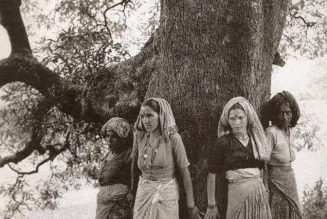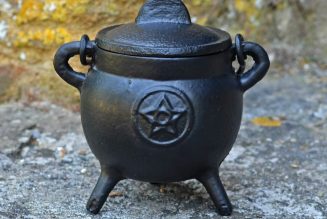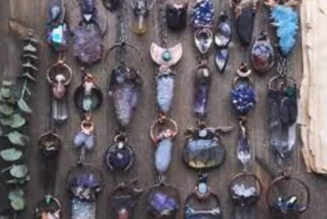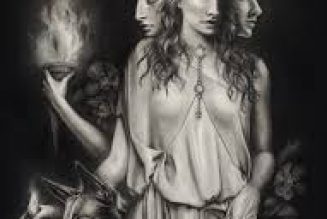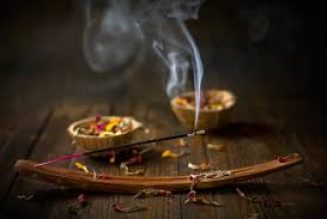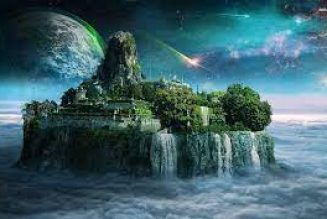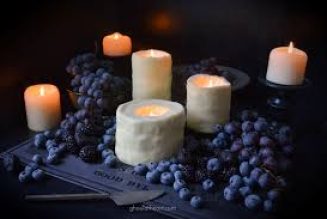Before you learn all the tarot card meanings, you should start at the basics: Tarot reading is the centuries-old practice of using a 78-card deck as a tool of divination—that is, the art or practice of discovering hidden knowledge or unusual insight through divine messages. Tarot card interpretation can be used to answer a multitude of questions by those who have learned and connected with their deck.
Whether you’re reading for yourself or others, the symbolism and stories interwoven with the tarot deck are meant to procure a reaction from the subconscious in order to make connections that might not have been seen otherwise. While tarot cards do not give the reader the ability to see the future, they are a way to reflect, react, and respond accordingly. (Not unlike how someone reads a horoscope for their sun sign, rising sign, and moon sign.)
Interested in learning tarot? Read on for all the tarot card names before you begin your own journey.
What are tarot cards?
Each card in a deck has its own unique imagery, and the deck as a whole is broken into two categories: the Major and Minor Arcana.
The Major Arcana consists of 22 cards, spanning from numbers 0 through 21 that tell “the fool’s journey.” In short, it’s an archetypal story of life. The Minor Arcana is made up of all four elements—fire, air, water, and earth are represented by wands, swords, cups, and pentacles respectively—and counts upward from ace to 10 and then through four court cards (page, knight, queen, king). The Major Arcana is said to represent big life-changing events, while the Minor Arcana usually represents people, feelings, and day-to-day occurrences.
What is the history of tarot?
Tarot cards are thought to have originated in the 15th century in Europe, more specifically in Italy, and originally the deck was called Tarocchi. The cards quickly gained traction throughout many other European countries after the French conquered Milan and the Piedmont in 1499. The Major Arcana, previously dubbed trump cards, were custom made and painted for wealthy families, including multiple decks that were created for the Visconti family in Milan. The oldest surviving cards are the 15 Visconti-Sforza tarot decks commissioned by Duke Filippo Maria Visconti between 1418 and 1425, which means that people have been learning how to read tarot cards for over 600 years.
What was the original purpose of tarot?
While we know that tarot cards were used in aristocratic society, their original purpose is still not fully known. Whether they were family heirlooms to be passed down to the next of kin, simply a fun customized card game, or something in between is up for debate. What matters now: Over time, tarot cards became symbolic divinatory tools. Their use has far expanded beyond their original purpose as they assist us with spiritual guidance and self-reflection.
What is the difference between tarot and oracle cards?
Tarot decks have to consist of exactly 78 cards made up of 22 Major Arcana cards and 56 Minor Arcana cards. No more and no less. They also need to include four different suits. In the traditional Rider-Waite deck, these are pentacles, swords, cups, and wands; however, some decks use different representations of these same four elements. Tarot will also always include court cards (traditionally page, knight, queen, and king), though some decks swap out pages for princesses or other minor shifts in the deck’s creative direction.
While oracle cards are used in a similar way—that is, as a tool of self-reflection—there are fewer rules. An oracle card deck can include any number of cards and meanings.
How can I learn how to read tarot?
Tarot as a tool of divination is meant to give clarity to the person being read for. That could be either you reading for yourself, you reading for someone else, or someone else reading for you. In order to learn how to read tarot, it’s important to start by understanding the meaning behind each archetypal card. Much as we learn words before we start stringing together sentences, knowing the meaning of the cards individually will the guide you as you read them in tarot card spreads.
How do you ask tarot questions?
When you are asking your tarot deck questions, it’s important to set an intention first. Try something like, “I call forth my spirit guides of the purest and highest intention to give me messages of clarity for each question being asked hereafter.” From that point, ask the tarot questions that are both specific and nonspecific. A specific question would be, “Should I move forward with the new job I was just offered?” or “Am I really falling in love?” Nonspecific questions sound more like, “Tell me about my current relationship.”
As you study the tarot, learn which cards represent yes or no within the deck to answer your own “yes/no” questions. However you choose to ask the tarot your questions, just be sure that it’s always done with sincere intentions and a level of respect for the guidance you’re seeking. Each answer will show itself through the cards, but it’s important to understand that tarot is not information written in stone. You always have free will and the power to change your approach to life, whether that’s to continue or to diverge from the path you’re currently on.
Why is it important to clean tarot?
If you’re the owner of the tarot deck you’re reading from—so, reading for yourself—keep your deck clean and treat it with care. Clean your deck by smoking it using sustainably harvested sage or palo santo, bathing it in the aura of cleansing crystals like clear quartz or selenite, or placing the cards under the moonlight. This helps clear energy away from previous readings and any influence not from a pure space; as a tool of divination, tarot cards can absorb energy from the people using it—so any past readings or spiritual entities that try to come through. Cleaning helps your deck maintain energetic integrity to ensure a more accurate tarot card reading.
What are tarot card spreads?
The position of the cards that you put down on the table to be read is called a tarot spread, meaning that cards are placed down in a specific order and spot, and each placement has its own meaning. Two of the most common tarot spreads include:
Past, Present, Future: A three-card spread in which the cards are placed with the leftmost (and first) representing the energy of the past, the middle representing what’s currently happening in the present, and the rightmost representing the energy of the future.
The Celtic Cross: A 10-card spread that starts with two cards pulled in the middle overlapping one another. These first two cards represent:
1. The central focus of the person being read for;
2. What is helping or hindering this focus presently.
Then cards are placed clockwise around these center two cards, starting with below, then left, above, and right. Their meanings are:
3. The subconscious (below);
4. The recent past, or events leading up to this moment (left);
5. The higher path or destiny (above);
6. What lies ahead, or the near future if you stay on your current path (right).
Then four cards are pulled up the right side of this central area from bottom to top. They are:
7. The questioner—that is, the person being read for and their energy;
8. Outside energy and influences and/or the questioner’s environment;
9. The questioner’s hopes and dreams;
10. The final result.
Most readers will say that the placements of the higher-path/destiny card (#5) and the final-result card (#10) are interchangeable if the questioner is willing to follow their intuition moving forward, as the destiny is the best possible outcome and the final result is what can happen given the culmination of other cards and their circumstances.
Both beginning readers and seasoned professionals use these two tarot spreads, and they work as a great foundation for those learning how to read. As with many things, it’s important to learn the basics of reading tarot before getting creative and branching out into your own unique style—which will come with time, practice, and experience!
Once you’re ready to get creative, you can even connect the tarot cards to your zodiac chart. Glamour’s monthly tarotscopes combine tarot with astrology to help guide the zodiac signs.
Which tarot cards represent which zodiac signs?
Although they are not intrinsically interwoven, there’s been a long-standing tradition of placing astrological influence onto each tarot card. This helps to get more accurate readings with timing and identifying the people whose energy is showing up in a reading. It’s said that each suit is associated with an element in the zodiac, so:
- Wands = fire sign energy;
- Cups = water sign energy;
- Pentacles = earth sign energy;
- Swords = air sign energy.
Each zodiac sign can also be seen in the Major Arcana cards. There’s a slight discrepancy between readers and which sign they assign to each Major Arcana card, but these are the discoveries that I’ve seen most accurately in my years of professional readings:
- Aries: The Emperor, The Fool;
- Taurus: The Hierophant, The Empress (Venus ruled);
- Gemini: The Lovers, The High Priestess (both showing duality);
- Cancer: Temperance, The Chariot, The Moon (Planetary Ruler);
- Leo: Strength;
- Virgo: The Hermit; secondary: The Maiden in Strength;
- Libra: Justice; secondary: The Empress (Venus ruled);
- Scorpio: Death
- Sagittarius: Judgment, Temperance
- Capricorn: The Devil
- Aquarius: The Star, The Hanged Man
- Pisces: The Moon
The World card and The Wheel of Fortune also represent and show imagery of the four fixed signs (Taurus, Leo, Scorpio, Aquarius), so it’s important to note that they all share influence over these two cards.
What is the most powerful tarot card?
Each of the 78 tarot cards holds different importance to each person who interprets them. The 22 Major Arcana cards are said to be representative of big, life-changing events in comparison with the Minor Arcana’s 56 cards, which are more indicative of emotions, people, and day-to-day experiences.
For this reason alone, we can say that one of the Majors is more likely to be the objectively most powerful card. This list below of the basic tarot card meanings can help you narrow down your decision on which one holds the most significance for you:
- The Fool: The first card of the tarot. The beginning and ending of everything, a quick change that requires a leap of faith. The Fool card, sometimes called the Idiot, represents infinite possibilities and potential—something no other card could accurately portray.
- Strength: Literally translating into power and inner strength, the Strength card is one that asks the questioner to reach deeply into their power reserves and push forward so they can overcome whatever is in their way.
- The Sun: The happiest card in the tarot deck, this represents positivity and optimism. Without a shadow of a doubt, a bright future lies ahead when this card is pulled.
- Death: As with happy, positive beginnings, sometimes new life is born from the ending of something else. Although it rarely indicates a physical death, the death card can signal an ending that will eventually lead into a new beginning for the questioner. This phoenix-rising-from-the ashes archetype is important and powerful, and it’s something that cannot be avoided in life. Once death is embraced, it can act as a powerful catalyst into change and transformation.
- The World: When this card is pulled, know that there is an undeniable sense of wholeness for the questioner. This card signals that a cycle has ended and all is well for the questioner. This card makes the pause before the next chapter it’s own important moment in time and usually represents achievement, fulfillment, successful conclusions, and endless possibilities that can come from it all.
What are the tarot card meanings?
Although every card cannot be the most powerful, they all hold an undeniable importance. See below for the meaning of all 78 of the tarot cards, starting with the 22 Major Arcana cards and then broken down into Ace through King of all four suits (cups, wands, pentacles, swords). Consider this Tarot Cards for Beginners.
